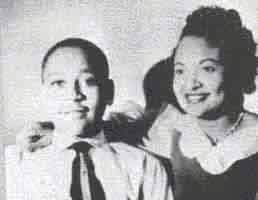The Death of Emmett
Till
The Mississippi Delta: Built on Racism and Oppression
The rich soil of the Mississippi Delta led the white
man to the region. In 1817, Mississippi became the twentieth state to enter the nation. At this time the Delta
area was populated by the Choctaw. They were removed from the land, in the Treaty of Doak's Stand of 1820. The
empty wilderness led the white settlers to claim vast portions of land and built an enormous empire of plantations.
The first white settlers who arrived in the region, between 1825 and 1827, and settled in the area today
known as Washington County which is located near the Mississippi River. Unlike most American pioneers, the whites
of the Delta did not settle the land with hard work. Rather they employed slaves to build their plantations. It
was is because of the swampy climate of the Delta that made it difficult for small farmers to settle in the region.
From the begining of white settlement in the Delta it was only a region for the wealthy and the slave owning. The
culture of white supremacy continued through the Civil War and beyond it, was a contributing factor to the Great
Migration.
By the 1850 census Washington County demonstrated approximately each white family owned 81.7 slaves and
67 percent of all white residences had moved to the Delta from other states. It was the rich soil of the Delta
that attracted the plantation owners to settle in the region and the rich soil lead to the cotton explosion and
the factors which propelled the overwhelming white supremacy in the south. |
|

Mississippi Delta
|
After the Civil War, cotton remained the dominate crop of the Mississippi Delta. The labor force to manage
the crop had been greatly reformed. The plantation owners were forced to adapt a system of sharecropping in which
former slaves farmed
Other factors also caused many families to leave the Delta. One of the most pressing and relevant issues
for the African American family was the racism and hatred that continued to filtrate through the south after the
Civil War ended. Segregation and racism were rampant in southern communities and success of an African American
was activity prevented. For if a African American became too successful or too powerful whether in an economic
or political sense, organizations such as the Klu Klux Klan would make an example of the individual farmer or political
leader. A continual suppression of African Americans prevailed in the south in an act to maintain the status quo
of the south before the Civil War.
One such example of the oppression of African Americans is found in the case of Emmett
Till. Emmett Till came to visit his grandparents in Leflore County from Chicago in August 1955. Brown
v. Board of Education had just found the segregation of schools to be unconstitutional. Tensions in Leflore
County were high as it was becoming apparent that the old system of oppression was crumbling. Emmett Till was killed
as an example to the rest African American community.
When Till arrived in Leflore County, he refused to follow the practices of the south.By not showing the
proper respect to the white members of the community. Till was reported to be standing around Roy Bryant's general
store and he was challenged by his friends to ask Carolyn Bryant, a white woman and wife of Roy |
|

Emmett Till and his mother, Mrs. Mamie Bradley, 1954
|
Bryant, for a date. He accepted the challenge and asked her. When she refused, Till reportedly said, "You
needn't be afraid of me, baby. I've been with a white woman before". It was at this point that Till's cousin
grabbed him from the store and rushed him into a car. Several days before Roy Bryant found out about the occurrence,
but when he did he and his half brother, J. W. Milam, went to the house of Till's grandparents, at two in the morning,
and demanded to see Emmett.
This lesson, was death. The body of Emmett Till was found on August 29, the day after the murder took place.
Emmett Till had been driven seventy miles from his home to the "scariest place in the Delta" and had
been repeatedly whipped and then shot in the head. When the bullet to the head did not kill Till, he was tied to
a gin fan and hung. His body then was thrown, naked, into a river.
Even though national attention was brought to the case, both Bryant and Milam were acquitted on all charges.
After the acquittal, Milam explained, "What could I do? He thought he was as good as any while man . . . I'm
no bully, I never hurt a niggah in my life. But I just decided it was time a dew people got put on notice. As long
as J. W. Milam lives and can do anything about it, niggahs are gonna stay in their place. Niggahs ain't gonna vote
where I live. If they did they'd control government. They'd tell me where to stand and where to sit. They ain't
gonna go to school with my kids. And when a niggah even gets close to mentioning sex with a white woman, her's
tired o'livin' . . . I'm gonna kill him". Till served as an example to African Americans of the Delta. many
hoped they would find freedom in the north.



